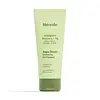What's inside
What's inside
 Key Ingredients
Key Ingredients

 Benefits
Benefits

 Concerns
Concerns

 Ingredients Side-by-side
Ingredients Side-by-side

Water
Skin ConditioningGlycerin
HumectantDecyl Glucoside
CleansingCoco-Glucoside
CleansingDisodium Cocoamphodiacetate
CleansingCocamidopropyl Hydroxysultaine
CleansingXanthan Gum
EmulsifyingSodium Levulinate
Skin ConditioningPotassium Sorbate
PreservativeAloe Barbadensis Leaf Juice
Skin ConditioningBetaine
HumectantVaccinium Myrtillus Fruit Extract
Skin ConditioningSaccharum Officinarum Extract
MoisturisingCitrus Aurantium Dulcis Fruit Extract
MaskingCitrus Limon Fruit Extract
MaskingAcer Saccharum Extract
Skin ConditioningButylene Glycol
HumectantCitrus Reticulata Peel Extract
Skin ConditioningMicrocrystalline Cellulose
AbsorbentTitanium Dioxide
Cosmetic ColorantAlpha-Arbutin
AntioxidantGlycyrrhiza Glabra Root Extract
BleachingSodium Gluconate
Skin ConditioningTerminalia Ferdinandiana Fruit Extract
AntioxidantArctostaphylos Uva Ursi Leaf Extract
Skin ConditioningCitrus Sinensis Peel Oil Expressed
PerfumingSodium Hyaluronate
HumectantWater, Glycerin, Decyl Glucoside, Coco-Glucoside, Disodium Cocoamphodiacetate, Cocamidopropyl Hydroxysultaine, Xanthan Gum, Sodium Levulinate, Potassium Sorbate, Aloe Barbadensis Leaf Juice, Betaine, Vaccinium Myrtillus Fruit Extract, Saccharum Officinarum Extract, Citrus Aurantium Dulcis Fruit Extract, Citrus Limon Fruit Extract, Acer Saccharum Extract, Butylene Glycol, Citrus Reticulata Peel Extract, Microcrystalline Cellulose, Titanium Dioxide, Alpha-Arbutin, Glycyrrhiza Glabra Root Extract, Sodium Gluconate, Terminalia Ferdinandiana Fruit Extract, Arctostaphylos Uva Ursi Leaf Extract, Citrus Sinensis Peel Oil Expressed, Sodium Hyaluronate
Water
Skin ConditioningDisodium Cocoamphodiacetate
CleansingDecyl Glucoside
CleansingGlycerin
HumectantCoco-Glucoside
CleansingCocamidopropyl Hydroxysultaine
CleansingXanthan Gum
EmulsifyingPotassium Sorbate
PreservativeBetaine
HumectantGlyceryl Glucoside
HumectantXylitylglucoside
HumectantTrehalose
HumectantLactic Acid
BufferingAloe Barbadensis Leaf Juice
Skin ConditioningSaccharide Isomerate
HumectantHyaluronic Acid
HumectantSodium Gluconate
Skin ConditioningLavandula Angustifolia Oil
MaskingSodium Hyaluronate
HumectantWater, Disodium Cocoamphodiacetate, Decyl Glucoside, Glycerin, Coco-Glucoside, Cocamidopropyl Hydroxysultaine, Xanthan Gum, Potassium Sorbate, Betaine, Glyceryl Glucoside, Xylitylglucoside, Trehalose, Lactic Acid, Aloe Barbadensis Leaf Juice, Saccharide Isomerate, Hyaluronic Acid, Sodium Gluconate, Lavandula Angustifolia Oil, Sodium Hyaluronate
Ingredients Explained
These ingredients are found in both products.
Ingredients higher up in an ingredient list are typically present in a larger amount.
Aloe Barbadensis Leaf Juice comes from leaves of the aloe plant. Aloe Barbadensis Leaf Juice is best known for helping to soothe sunburns. It is also anti-inflammatory, moisturizing, antiseptic, and can help heal wounds.
Aloe is packed with good stuff including Vitamins A, C, and E. These vitamins are antioxidants, which help fight free-radicals and the damage they may cause. Free-radicals are molecules that may damage your skin cells, such as pollution.
Aloe Barbadensis Leaf Juice also contains sugars. These sugars come in the form of monosaccharides and polysaccharides, folic acid, and choline. These sugars are able to help bind moisture to skin.
It also contains minerals such as calcium, 12 anthraquinones, fatty acids, amino acids, and Vitamin B12.
Learn more about Aloe Barbadensis Leaf JuiceBetaine is a common humectant (a substance that promotes retention of moisture). It's known to be gentle on the skin and can help balance hydration.
This ingredient is best for improving hydration and soothing irritated skin. Studies also show it helps even out skin tone.
Fun fact: Betaine is naturally created in the skin and body. The kind found within cosmetic products can be either plant-derived or synthetic.
Another name for betaine is trimethylglycine.
Learn more about BetaineCocamidopropyl Hydroxysultaine is a synthetic cleansing agent, though it is derived from coconut oil.
It is used to enhance the texture of products by boosting lather and thickening the texture. As a cleanser, Cocamidopropyl Hydroxysultaine is mild.
Coco-Glucoside is a surfactant, or a cleansing ingredient. It is made from glucose and coconut oil.
Surfactants help gather dirt, oil, and other pollutants from your skin to be rinsed away.
This ingredient is considered gentle and non-comedogenic. However, it may still be irritating for some.
Learn more about Coco-GlucosideDecyl Glucoside is a glucose-based surfactant and emulsion stabilizer. It is created by reacting glucose with the fatty acids from plants.
Surfactants help clean the skin by trapping oil, sebum, and dirt to be washed away. As an emulsion stabilizer, it stabilizes the ingredients in a product by preventing them from separating.
This ingredient is biodegradable and non-toxic. This ingredient is commonly found in baby shampoos.
Decyl Glucoside is sometimes used to stabilize the UV filter Tinosorb.
Learn more about Decyl GlucosideDisodium Cocoamphodiacetate is a surfactant and helps cleanse skin. It is created from the fatty acids of coconut oil.
Surfactants help rinse oil, dirt, and other pollutants easily from skin. It has a faint fruit-like scent.
Glycerin is already naturally found in your skin. It helps moisturize and protect your skin.
A study from 2016 found glycerin to be more effective as a humectant than AHAs and hyaluronic acid.
As a humectant, it helps the skin stay hydrated by pulling moisture to your skin. The low molecular weight of glycerin allows it to pull moisture into the deeper layers of your skin.
Hydrated skin improves your skin barrier; Your skin barrier helps protect against irritants and bacteria.
Glycerin has also been found to have antimicrobial and antiviral properties. Due to these properties, glycerin is often used in wound and burn treatments.
In cosmetics, glycerin is usually derived from plants such as soybean or palm. However, it can also be sourced from animals, such as tallow or animal fat.
This ingredient is organic, colorless, odorless, and non-toxic.
Glycerin is the name for this ingredient in American English. British English uses Glycerol/Glycerine.
Learn more about GlycerinPotassium Sorbate is a preservative used to prevent yeast and mold in products. It is commonly found in both cosmetic and food products.
This ingredient comes from potassium salt derived from sorbic acid. Sorbic acid is a natural antibiotic and effective against fungus.
Both potassium sorbate and sorbic acid can be found in baked goods, cheeses, dried meats, dried fruit, ice cream, pickles, wine, yogurt, and more.
You'll often find this ingredient used with other preservatives.
Learn more about Potassium SorbateThis is the synthetic salt of gluconic acid, a form of PHA and mild exfoliant.
It is mainly used to stabilize oil and butter formulations from going bad. Sodium gluconate is a humectant, pH regulator, and chelating agent.
Chelating agents help neutralize unwanted metals from affecting the formulation.
Sodium gluconate is water-soluble.
Learn more about Sodium GluconateSodium Hyaluronate is hyaluronic acid's salt form. It is commonly derived from the sodium salt of hyaluronic acid.
Like hyaluronic acid, it is great at holding water and acts as a humectant. This makes it a great skin hydrating ingredient.
Sodium Hyaluronate is naturally occurring in our bodies and is mostly found in eye fluid and joints.
These are some other common types of Hyaluronic Acid:
Learn more about Sodium HyaluronateWater. It's the most common cosmetic ingredient of all. You'll usually see it at the top of ingredient lists, meaning that it makes up the largest part of the product.
So why is it so popular? Water most often acts as a solvent - this means that it helps dissolve other ingredients into the formulation.
You'll also recognize water as that liquid we all need to stay alive. If you see this, drink a glass of water. Stay hydrated!
Learn more about WaterXanthan gum is used as a stabilizer and thickener within cosmetic products. It helps give products a sticky, thick feeling - preventing them from being too runny.
On the technical side of things, xanthan gum is a polysaccharide - a combination consisting of multiple sugar molecules bonded together.
Xanthan gum is a pretty common and great ingredient. It is a natural, non-toxic, non-irritating ingredient that is also commonly used in food products.
Learn more about Xanthan Gum